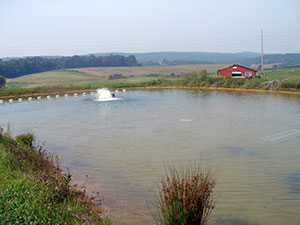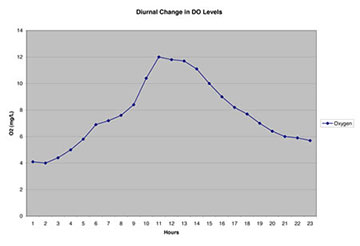Dissolved Oxygen Management and Related Costs in Pond Aquaculture
Dissolved oxygen control is critical in fish farming and other forms of aquaculture. Dissolved oxygen in aquaculture (DO), the volume of oxygen contained in water, is often the most critical parameter in the health and well-being of your livestock. In general, most fish species will grow and thrive within a DO range of 5–12 mg/L (ppm). However, if levels drop below 4 mg/L some species may stop feeding, become stressed and begin to die. This series of events can start a chain reaction in a pond aquaculture system that could prove detrimental.
Oxygen depletion usually occurs in the summer months because warmer water holds less oxygen than cooler water. For example, water with a temperature of 32ºC can hold up to 7.3 mg/L of oxygen, while 7ºC water can hold 12.1 mg/L. As water temperatures rise, oxygen levels decrease. Higher temperatures also increase the metabolic rate of fish, resulting in the need for more oxygen in your fish farming operation.
In the summer months, ponds can undergo stratification because of differences in water densities with differing temperatures. Cooler water sinks, warmer water rises, and the water at the top of the pond is heated more rapidly through radiation by the sun.
Although the pond's cooler bottom temperature holds more dissolved oxygen when the summer starts, as the summer progresses microbial decomposition of organic materials depletes oxygen at the pond's bottom.
According to some studies, the 24-hour oxygen consumption of the pond bottom changes between 1 and 3 mg/L (calculating with 1 m of water depth). In addition, the natural diurnal cycle in aquatic systems fluctuates greatly and can be exacerbated in aquaculture systems with high stocking densities. See the Graph below for an average pond's DO diurnal cycle.

In order to accurately understand these differences and changes, most fish farmers use oxygen sensors to monitor dissolved oxygen and prevent depletion through monitoring and control. If levels drop too low, an aeration system can quickly increase dissolved oxygen levels. Some farms operate more manually, with workers checking ponds with a handheld instrument (such as the YSI ProSolo), then turning on an aerator or paddle wheel as necessary. Ponds can still be checked manually to validate the continuous monitor.
As energy costs rise, reducing ongoing operating expenses becomes more and more important in an operation. Automatic monitoring with control can have significant cost savings. Field testing shows that, on average, an automatic system reduces the need for aeration by 4 hours per night.
More efficient systems allow for an instrument like the YSI 5500D or 5400 multiDO to continuously monitor ponds and automatically control an aeration system based on preset levels. This allows farms to operate aerating systems more efficiently, which significantly reduces energy costs and allows labor personnel to be used in other areas.
Scenario
If we assume two 10-hp paddle wheel aerators per pond on a farm with 8 large ponds, we can determine cost savings.
Most energy costs are reported in cents per kilowatt-hour ($/kWh).
If we assume 0.1062/kWh for the energy cost and we use the following formula to calculate the cost, we could realize significant savings through automation of dissolved oxygen management in aquaculture systems.
Energy Cost Savings Example*
$ = hp x .746 x $/kWh x (4 hours saved per night)
(hp is total horsepower and .746 is the conversion from hp to kW)
With two aerators per pond, running approximately 10 hours per night, the electricity costs saved would be:
(2 x 10 hp) x .746 x $0.1062/kWh x 4 hrs saved = $6.34 per night per pond
$6.34 per night per pond x 8 ponds = $50.72 per night total
$50.72 per night total x 30 days = $1,521.60 per month or $18,512.80 per year!
*kWh cost average for commercial based on 10.62 cents for 2020. Source www.eia.doe.gov
You can do the math for even larger farms. If there was a farm operating with 50 ponds, for example, this cost savings could be realized to the tune of $9,510 per month!
Not only can this system save on energy costs, but it can also have definite added benefits. Personnel can be used in other areas of the operation more efficiently, costly fish losses can be prevented and food costs can be reduced by feeding only when the conditions are optimal to feed. The Feed Smart® software built into the 5400 allows you to also control your automatic feeders and account directly for feed conversion ratios (FCRs). Your operation can also be expanded with the YSI IOEM Input, Output expansion module, or the Relay expansion module.
In addition, the method used to add aeration could last much longer because the "on" time could potentially be much less.
Ultimately, you have to make a decision for your operation regarding continual DO monitoring and control. Continuous, automatic DO monitoring can eliminate fish loss, reduce labor and energy costs, yield more productive ponds, help make better pond management decisions and provide valuable peace of mind.


Additional Blog Posts of Interest:
Improve Efficiency with Aquaculture Monitoring and Control Technology
Pond Based Aquaculture | Understanding Ammonia
Nitrate Levels in Aquaculture May Be More Dangerous Than You Think
Aquaculture Raceway Shrimp Production with Dissolved Oxygen Monitoring